Module 11 Body language Unit 1 They touch noses!课件50张缺少音频
文档属性
| 名称 | Module 11 Body language Unit 1 They touch noses!课件50张缺少音频 | 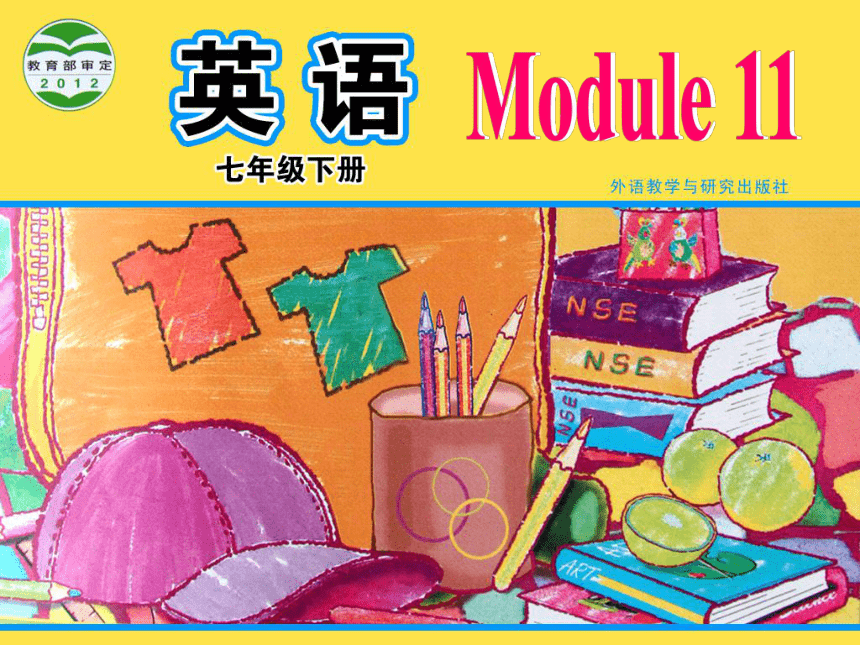 | |
| 格式 | zip | ||
| 文件大小 | 5.4MB | ||
| 资源类型 | 教案 | ||
| 版本资源 | 外研版 | ||
| 科目 | 英语 | ||
| 更新时间 | 2019-06-03 16:17:17 | ||
图片预览

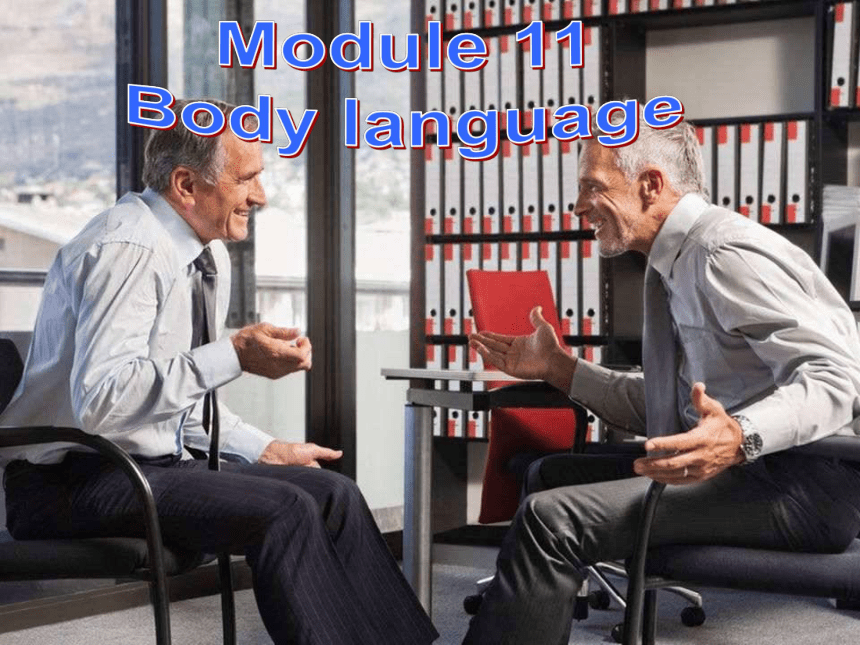
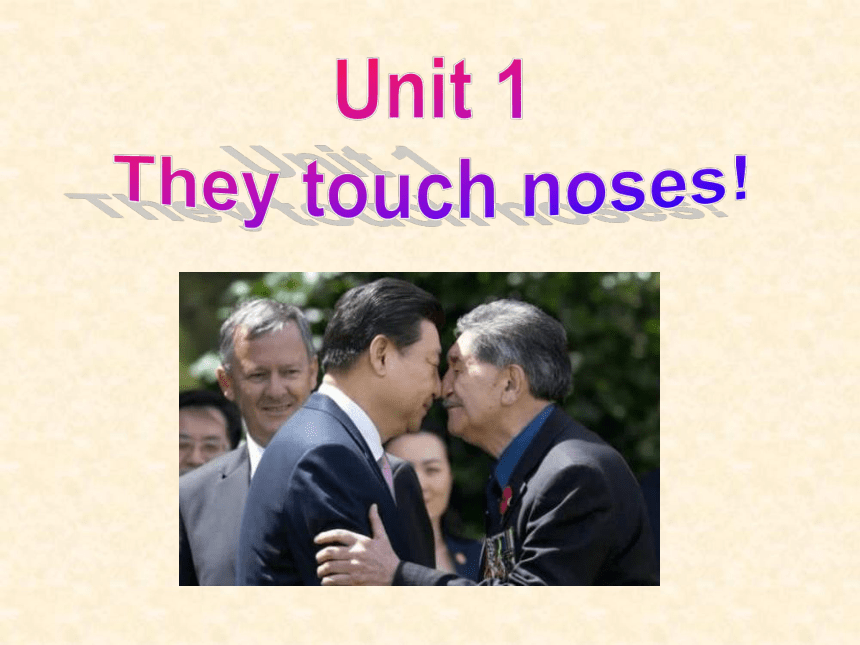

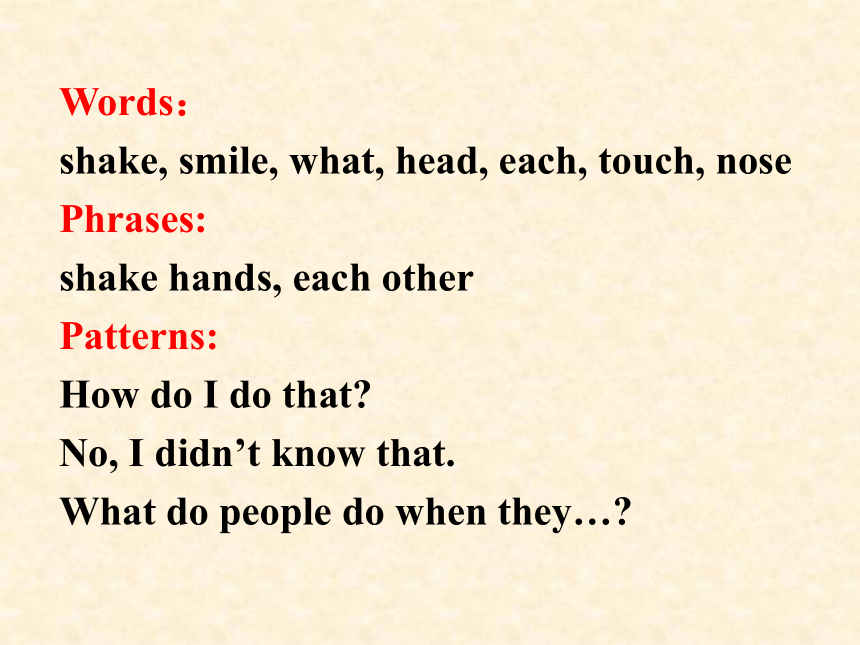
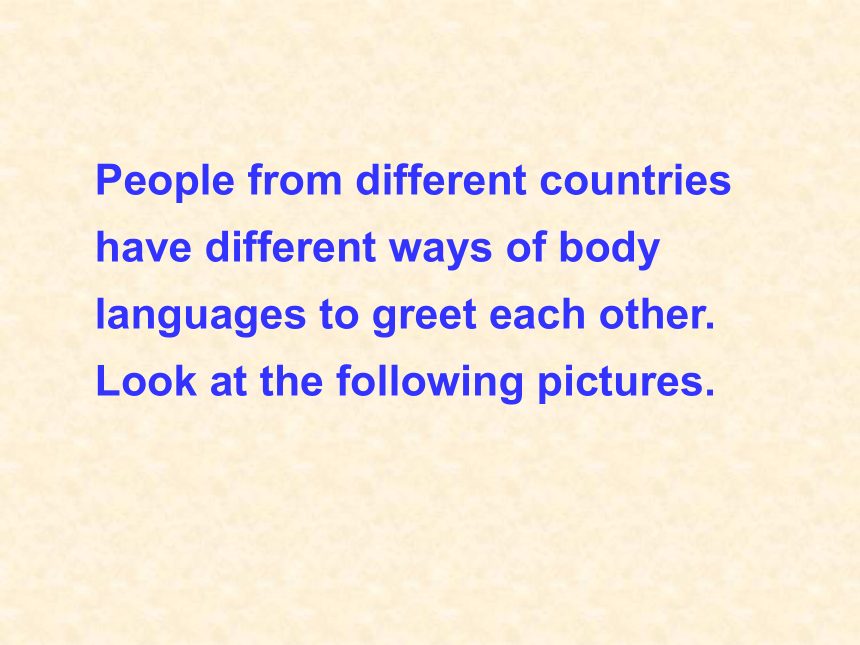


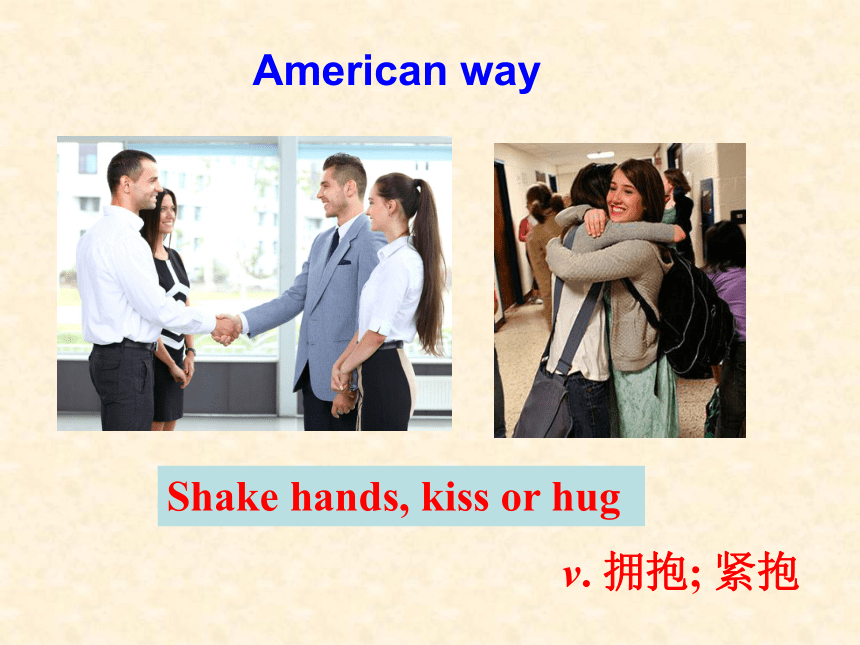
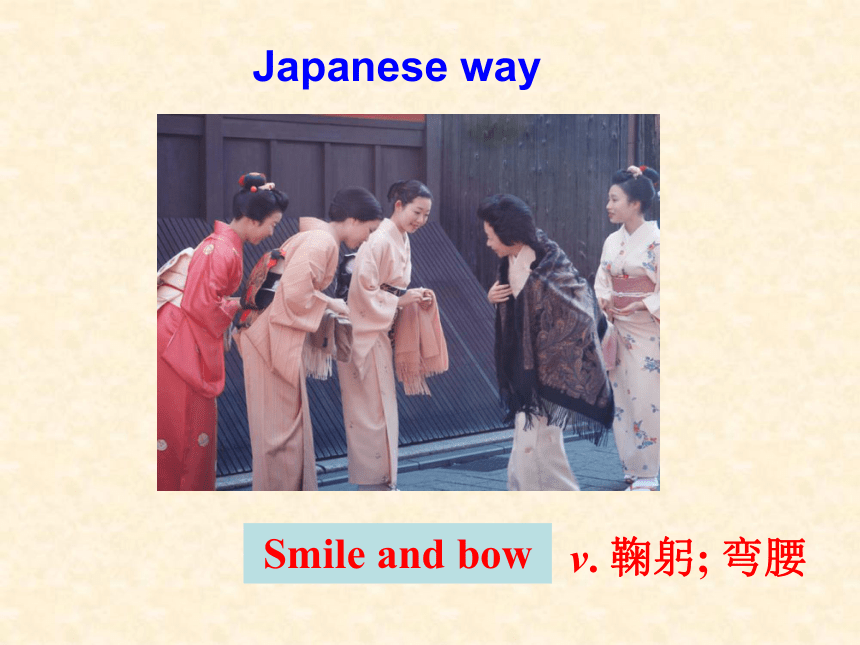
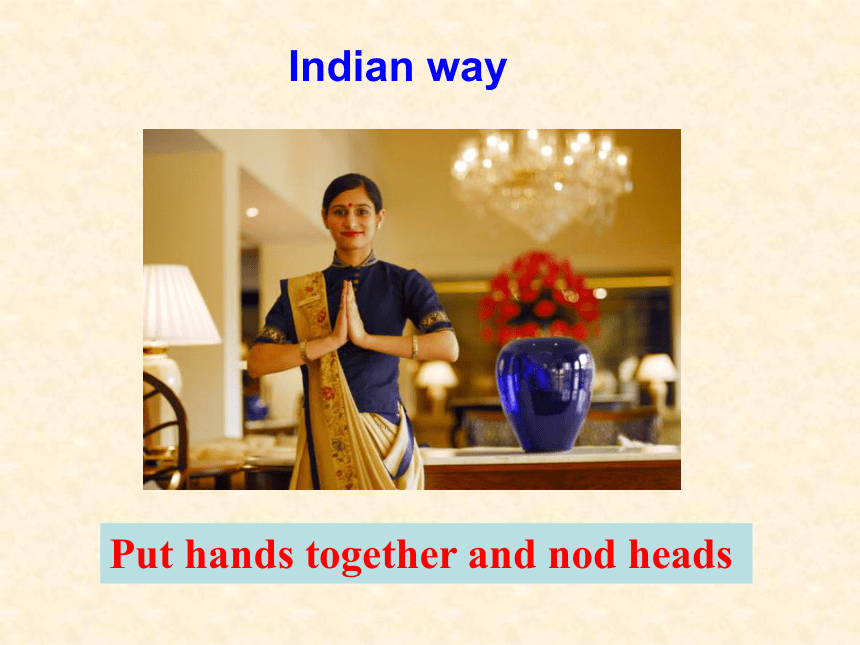
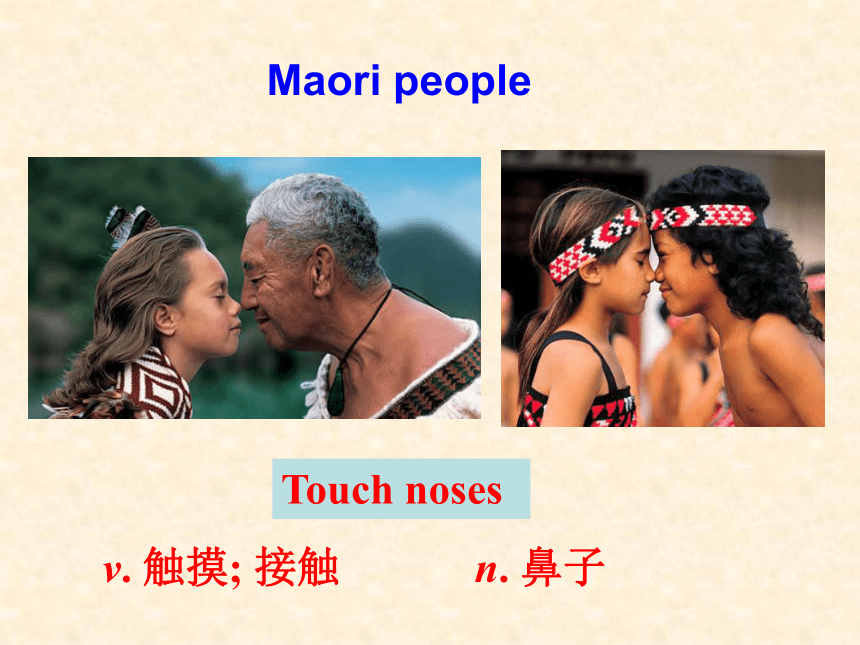
文档简介
1. To understand what is talked about in the conversation
2. To learn the key words and useful
expressions in the dialogue
3. To talk briefly about the body language people use when they meet in some countries
Words:
shake, smile, what, head, each, touch, nose
Phrases:
shake hands, each other
Patterns:
How do I do that?
No, I didn’t know that.
What do people do when they…?
People from different countries have different ways of body languages to greet each other. Look at the following pictures.
Chinese way
Shake hands and smile
shake v. 摇晃
v. & n. 微笑
shake hands 握手
Russian way
Kiss three times
v. & n. 吻; 亲吻
American way
Shake hands, kiss or hug
v. 拥抱; 紧抱
Japanese way
Smile and bow
v. 鞠躬; 弯腰
Indian way
Put hands together and nod heads
Maori people
Touch noses
v. 触摸; 接触
n. 鼻子
British adj.
英国的; 英国人的
German
n. 德国人; 德语
adj. 德国的; 德国人的; 德语的
Japanese
n. 日本人; 日语
adj. 日本的; 日语的; 日本人的
Russian
n. 俄罗斯人; 俄语
adj. 俄罗斯的; 俄罗斯人的; 俄语的
Russia
俄罗斯
visitor
n. 游客; 观光者
nod v. 点(头)
head n. 头; 头部
India 印度
Maori
adj. 毛利人的
3
2
1
Match the pictures with the words and expression from the box.
1/2/3
Listen and match the pictures with the nationality.
3
2
1
Tapescript:
Daming: What are they doing?
Betty: They are saying hello. They’re
kissing.
Daming: Are they German? Or British?
Betty: Maybe they’re French.
Daming: And these people are shaking
hands. I think they’re Russian.
Betty: I think so too. And these
people are Japanese, I think.
Daming: Why?
Betty: Because they’re smiling at
each other and bowing.
— Are they Russian?
— Yes, they are.
— What are they doing?
— They’re shaking hands.
Now work in pairs and check.
— Are they French?
— Yes, they are.
— What are they doing?
— They’re saying hello and kissing.
— Are they Japanese?
— Yes, they are.
— What are they doing?
— They’re smiling at each other and
bowing.
Watch the video.
1. Who will come to Lingling’s school?
Some Russian teachers.
2. What will Maori people do when they
meet?
They will touch noses.
India kiss Russia together touch visitor
Now complete the table with the correct form of the words from the box.
kiss
visitors
In China, people shake hands and smile
when they meet
(6) ________.
American people shake hands and sometimes
(1) ______
India
together
Russia
touch
visitors
In (2) ______, people put their hands (3) ________ and nod their heads
when they meet
(6) ________.
In (4) _______, people kiss each other three times
Maori people (5) ______ noses.
People in different countries may use different body language to express the same meaning and feelings. When you speak with people from other countries, try to understand
and respect their
body language.
Chinese each French
teacher touch
British shake
people
French
British
Listen and repeat.
your teacher
your head teacher
your parents after school
Talk about what you do and say when you meet:
your best friend
your best friend’s parents
your favorite film star
a visitor to your school
an American
a Russian
— What do you do and say when you
meet your teacher in the morning?
— I smile and say good morning.
— What do you do and say when you
meet a Russian?
— I smile, say hello and kiss each
other three times.
— What do you do and say when you
meet your parents after school?
— Kiss and hug each other.
握手
互相;彼此
身势语
碰鼻子
shake hands?
each other?
body language?
touch noses?
Ⅰ.?根据语境从方框中选择恰当的单词填空,有的需要变换形式,每词限用一次。
head, bow, smile, together, German
1. He stood in front of his fans with a big ________.
2. Mr Yang is kind. He always ________ before giving a talk.
3. Look! Here are those ________ doctors.
smile
bows
German
head, bow, smile, together, German
4. The little girl with a round ________ began to sing.
5. They are good friends. And they often study and play ________.
head
together
Ⅱ.?根据语境及所给汉语提示语写出所缺单词。
1. Try the ________(俄罗斯的) beef. It is delicious.
2. He comes from ________(印度). He is twelve years old.
3. ________(什么)! My cat is lost?
4. She ________(拥抱) her friends and then got on the train.
5. The boy ________(触摸) the bowl. Oh, it was too hot.
Russian
India
What?
hugged
touched
Ⅲ.?根据汉语意思完成英语句子,每空一词(含缩略形式)。
1.?坐下之前他们握了手。
They ________ ________ before they sat down.
2.?在团队中互相帮助很重要。
It is important to help ________ ________ in a team.
3.?这是一本关于身势语的书。
This is a book about ________ ________.?
shook hands?
each
other
body language
4.?那是因为下雪了。
________ ________ it snowed.
5.?毛利人见面时碰鼻子。
Maori people ________ ________ when they meet.?????????
That’s because?
touch noses
1. We Chinese often shake hands and
smile.
shake作动词,意为“______”。表示
“(和某人)握手”时,用短语shake
hands (with sb.)。
摇晃
e.g. _____________ before drinking.
喝之前摇晃果汁。
Who is _________________ your
uncle??
谁在和你叔叔握手?
Shake the juice
shaking hands with
smile
smile意为“微笑”,既可作动词,也可作名词。
e.g. The boy smiled when he saw his
friend. (翻译)
She _______________.
她微笑着离开了。
left with a smile
这个男孩看到他朋友时笑了。
2. That’s because people do different things in different countries.
That’s because ...是一个常用句式,表示“那是因为……”,后跟句子说明具体原因。
e.g. That’s because it’s late. (翻译)
那是因为天晚了。
【链接】
That’s why ...也是一个常用句式,后跟句子说明结果,表示“那就是为什么……”。如:
That’s why he got the best scores.
那就是为什么他取得了最好的成绩。
3. 名词的复数:
German → Germans
Japanese → Japanese
Russian → Russians
4. And some kiss or hug each other.
each other表示“彼此,互相”, 通常放
在动词后。
5. In India people put their hands together
and nod their heads.
put … together表示“把……放在一起”。
6. They touch noses!
touch noses “碰鼻子”。
Write a short passage about the greeting ways in China.
2. To learn the key words and useful
expressions in the dialogue
3. To talk briefly about the body language people use when they meet in some countries
Words:
shake, smile, what, head, each, touch, nose
Phrases:
shake hands, each other
Patterns:
How do I do that?
No, I didn’t know that.
What do people do when they…?
People from different countries have different ways of body languages to greet each other. Look at the following pictures.
Chinese way
Shake hands and smile
shake v. 摇晃
v. & n. 微笑
shake hands 握手
Russian way
Kiss three times
v. & n. 吻; 亲吻
American way
Shake hands, kiss or hug
v. 拥抱; 紧抱
Japanese way
Smile and bow
v. 鞠躬; 弯腰
Indian way
Put hands together and nod heads
Maori people
Touch noses
v. 触摸; 接触
n. 鼻子
British adj.
英国的; 英国人的
German
n. 德国人; 德语
adj. 德国的; 德国人的; 德语的
Japanese
n. 日本人; 日语
adj. 日本的; 日语的; 日本人的
Russian
n. 俄罗斯人; 俄语
adj. 俄罗斯的; 俄罗斯人的; 俄语的
Russia
俄罗斯
visitor
n. 游客; 观光者
nod v. 点(头)
head n. 头; 头部
India 印度
Maori
adj. 毛利人的
3
2
1
Match the pictures with the words and expression from the box.
1/2/3
Listen and match the pictures with the nationality.
3
2
1
Tapescript:
Daming: What are they doing?
Betty: They are saying hello. They’re
kissing.
Daming: Are they German? Or British?
Betty: Maybe they’re French.
Daming: And these people are shaking
hands. I think they’re Russian.
Betty: I think so too. And these
people are Japanese, I think.
Daming: Why?
Betty: Because they’re smiling at
each other and bowing.
— Are they Russian?
— Yes, they are.
— What are they doing?
— They’re shaking hands.
Now work in pairs and check.
— Are they French?
— Yes, they are.
— What are they doing?
— They’re saying hello and kissing.
— Are they Japanese?
— Yes, they are.
— What are they doing?
— They’re smiling at each other and
bowing.
Watch the video.
1. Who will come to Lingling’s school?
Some Russian teachers.
2. What will Maori people do when they
meet?
They will touch noses.
India kiss Russia together touch visitor
Now complete the table with the correct form of the words from the box.
kiss
visitors
In China, people shake hands and smile
when they meet
(6) ________.
American people shake hands and sometimes
(1) ______
India
together
Russia
touch
visitors
In (2) ______, people put their hands (3) ________ and nod their heads
when they meet
(6) ________.
In (4) _______, people kiss each other three times
Maori people (5) ______ noses.
People in different countries may use different body language to express the same meaning and feelings. When you speak with people from other countries, try to understand
and respect their
body language.
Chinese each French
teacher touch
British shake
people
French
British
Listen and repeat.
your teacher
your head teacher
your parents after school
Talk about what you do and say when you meet:
your best friend
your best friend’s parents
your favorite film star
a visitor to your school
an American
a Russian
— What do you do and say when you
meet your teacher in the morning?
— I smile and say good morning.
— What do you do and say when you
meet a Russian?
— I smile, say hello and kiss each
other three times.
— What do you do and say when you
meet your parents after school?
— Kiss and hug each other.
握手
互相;彼此
身势语
碰鼻子
shake hands?
each other?
body language?
touch noses?
Ⅰ.?根据语境从方框中选择恰当的单词填空,有的需要变换形式,每词限用一次。
head, bow, smile, together, German
1. He stood in front of his fans with a big ________.
2. Mr Yang is kind. He always ________ before giving a talk.
3. Look! Here are those ________ doctors.
smile
bows
German
head, bow, smile, together, German
4. The little girl with a round ________ began to sing.
5. They are good friends. And they often study and play ________.
head
together
Ⅱ.?根据语境及所给汉语提示语写出所缺单词。
1. Try the ________(俄罗斯的) beef. It is delicious.
2. He comes from ________(印度). He is twelve years old.
3. ________(什么)! My cat is lost?
4. She ________(拥抱) her friends and then got on the train.
5. The boy ________(触摸) the bowl. Oh, it was too hot.
Russian
India
What?
hugged
touched
Ⅲ.?根据汉语意思完成英语句子,每空一词(含缩略形式)。
1.?坐下之前他们握了手。
They ________ ________ before they sat down.
2.?在团队中互相帮助很重要。
It is important to help ________ ________ in a team.
3.?这是一本关于身势语的书。
This is a book about ________ ________.?
shook hands?
each
other
body language
4.?那是因为下雪了。
________ ________ it snowed.
5.?毛利人见面时碰鼻子。
Maori people ________ ________ when they meet.?????????
That’s because?
touch noses
1. We Chinese often shake hands and
smile.
shake作动词,意为“______”。表示
“(和某人)握手”时,用短语shake
hands (with sb.)。
摇晃
e.g. _____________ before drinking.
喝之前摇晃果汁。
Who is _________________ your
uncle??
谁在和你叔叔握手?
Shake the juice
shaking hands with
smile
smile意为“微笑”,既可作动词,也可作名词。
e.g. The boy smiled when he saw his
friend. (翻译)
She _______________.
她微笑着离开了。
left with a smile
这个男孩看到他朋友时笑了。
2. That’s because people do different things in different countries.
That’s because ...是一个常用句式,表示“那是因为……”,后跟句子说明具体原因。
e.g. That’s because it’s late. (翻译)
那是因为天晚了。
【链接】
That’s why ...也是一个常用句式,后跟句子说明结果,表示“那就是为什么……”。如:
That’s why he got the best scores.
那就是为什么他取得了最好的成绩。
3. 名词的复数:
German → Germans
Japanese → Japanese
Russian → Russians
4. And some kiss or hug each other.
each other表示“彼此,互相”, 通常放
在动词后。
5. In India people put their hands together
and nod their heads.
put … together表示“把……放在一起”。
6. They touch noses!
touch noses “碰鼻子”。
Write a short passage about the greeting ways in China.
同课章节目录
- Module 1 Lost and found
- Unit 1 Whose bag is this?
- Unit 2 Are they yours?
- Unit 3 Language in use
- Module 2 What can you do ?
- Unit 1 I can play the piano
- Unit 2 I can run really fast
- Unit 3 Language in use
- Module 3 Making plans
- Unit 1 What are you going to do at the weekends?
- Unit 2 We're going to cheer the players.
- Unit 3 Language in use
- Module 4 Life in the future
- Unit 1 Everyone will study at home
- Unit 2 Every family will have a small plane.
- Unit 3 Language in use
- Module 5 Shopping
- Unit 1 What can I do for you?
- Unit 2 You can buy everything on the Internet
- Unit 3 Language in use
- Module 6 Around town
- Unit 1 Could you tell me how to get to the Nationa
- Unit 2 The London Eye is on your right.
- Unit 3 Language in use
- Revision module A
- Module 7 My past life
- Unit 1 I was born in a small village.
- Unit 2 I was born in Quincy.
- Unit 3 Language in use
- Module 8 Story time
- Unit 1 Once upon a time….
- Unit 2 Goldilocks hurried out of the house.
- Unit 3 Language in use
- Module 9 Life history
- Unit 1 He left school and began work at the age of
- Unit 2 He decided to be an actor.
- Unit 3 Language in use
- Module 10 A holiday journey
- Unit 1 What did you do?
- Unit 2 This morning we took a walk.
- Unit 3 Language in use
- Module 11 Body language
- Unit 1 They touch noses!
- Unit 2 Here are some ways to welcome them.
- Unit 3 Language in use
- Module 12 Western music
- Unit 1 It's so beautiful!
- Unit 2 Vienna is the centre of European classical
- Unit 3 Language in use
- Revision module B
